Une partie des informations de ce site Web a été fournie par des sources externes. Le gouvernement du Canada n'assume aucune responsabilité concernant la précision, l'actualité ou la fiabilité des informations fournies par les sources externes. Les utilisateurs qui désirent employer cette information devraient consulter directement la source des informations. Le contenu fourni par les sources externes n'est pas assujetti aux exigences sur les langues officielles, la protection des renseignements personnels et l'accessibilité.
L'apparition de différences dans le texte et l'image des Revendications et de l'Abrégé dépend du moment auquel le document est publié. Les textes des Revendications et de l'Abrégé sont affichés :
| (12) Demande de brevet: | (11) CA 2255860 |
|---|---|
| (54) Titre français: | EQUIPEMENT TUBULAIRE EN MATERIAUX COMPOSITES REALISES PAR ENROULEMENT DE TISSUS DESEQUILIBRES EN TRAME SUR UN MANDRIN COMPRESSIBLE |
| (54) Titre anglais: | COMPOSITE MATERIAL TUBULAR EQUIPMENT PRODUCED BY WINDING OF WEFT-UNBALANCED WOVEN FABRIC ON A COMPRESSIBLE MANDREL |
| Statut: | Réputée abandonnée et au-delà du délai pour le rétablissement - en attente de la réponse à l’avis de communication rejetée |
| (51) Classification internationale des brevets (CIB): |
|
|---|---|
| (72) Inventeurs : |
|
| (73) Titulaires : |
|
| (71) Demandeurs : |
|
| (74) Agent: | MARKS & CLERK |
| (74) Co-agent: | |
| (45) Délivré: | |
| (86) Date de dépôt PCT: | 1997-05-23 |
| (87) Mise à la disponibilité du public: | 1997-11-27 |
| Licence disponible: | S.O. |
| Cédé au domaine public: | S.O. |
| (25) Langue des documents déposés: | Anglais |
| Traité de coopération en matière de brevets (PCT): | Oui |
|---|---|
| (86) Numéro de la demande PCT: | PCT/FR1997/000909 |
| (87) Numéro de publication internationale PCT: | FR1997000909 |
| (85) Entrée nationale: | 1998-11-23 |
| (30) Données de priorité de la demande: | ||||||
|---|---|---|---|---|---|---|
|
Tubes, pieux, mâts en matériaux composites soumis à des efforts de compression axiale ou de flexion, réalisés par enroulement adapté de tissus déséquilibrés en trame, telle que la partie principale de fibres de renforcement, sont placés parallèlement à l'axe longitudinal de la structure. Les tubes, pieux et mâts sont réalisés par enroulement sur un mandrin compressible, pour assurer le démandrinage sans contraindre, ni microfissurer les tubes.
The invention discloses composite material tubes, piles, masts subjected to
axial compression or bending stresses, produced by an adapted winding of weft-
unbalanced woven fabric, such that the main portion of reinforcement fibres is
placed parallel to the longitudinal axis of the structure. The tubes, piles
and masts are produced by winding on a compressible mandrel to ensure that the
tubes are not stressed or subjected to micro-cracking when the mandrel plug is
pulled out.
Note : Les revendications sont présentées dans la langue officielle dans laquelle elles ont été soumises.
Note : Les descriptions sont présentées dans la langue officielle dans laquelle elles ont été soumises.

2024-08-01 : Dans le cadre de la transition vers les Brevets de nouvelle génération (BNG), la base de données sur les brevets canadiens (BDBC) contient désormais un Historique d'événement plus détaillé, qui reproduit le Journal des événements de notre nouvelle solution interne.
Veuillez noter que les événements débutant par « Inactive : » se réfèrent à des événements qui ne sont plus utilisés dans notre nouvelle solution interne.
Pour une meilleure compréhension de l'état de la demande ou brevet qui figure sur cette page, la rubrique Mise en garde , et les descriptions de Brevet , Historique d'événement , Taxes périodiques et Historique des paiements devraient être consultées.
| Description | Date |
|---|---|
| Inactive : CIB de MCD | 2006-03-12 |
| Inactive : CIB de MCD | 2006-03-12 |
| Inactive : CIB de MCD | 2006-03-12 |
| Inactive : CIB de MCD | 2006-03-12 |
| Le délai pour l'annulation est expiré | 2001-05-23 |
| Demande non rétablie avant l'échéance | 2001-05-23 |
| Réputée abandonnée - omission de répondre à un avis sur les taxes pour le maintien en état | 2000-05-23 |
| Inactive : CIB en 1re position | 1999-02-05 |
| Symbole de classement modifié | 1999-02-05 |
| Inactive : CIB attribuée | 1999-02-05 |
| Inactive : CIB attribuée | 1999-02-05 |
| Inactive : Notice - Entrée phase nat. - Pas de RE | 1999-01-20 |
| Demande reçue - PCT | 1999-01-18 |
| Demande publiée (accessible au public) | 1997-11-27 |
| Date d'abandonnement | Raison | Date de rétablissement |
|---|---|---|
| 2000-05-23 |
Le dernier paiement a été reçu le 1998-11-23
Avis : Si le paiement en totalité n'a pas été reçu au plus tard à la date indiquée, une taxe supplémentaire peut être imposée, soit une des taxes suivantes :
Les taxes sur les brevets sont ajustées au 1er janvier de chaque année. Les montants ci-dessus sont les montants actuels s'ils sont reçus au plus tard le 31 décembre de l'année en cours.
Veuillez vous référer à la page web des
taxes sur les brevets
de l'OPIC pour voir tous les montants actuels des taxes.
| Type de taxes | Anniversaire | Échéance | Date payée |
|---|---|---|---|
| TM (demande, 2e anniv.) - petite | 02 | 1999-05-25 | 1998-11-23 |
| Taxe nationale de base - petite | 1998-11-23 |
Les titulaires actuels et antérieures au dossier sont affichés en ordre alphabétique.
| Titulaires actuels au dossier |
|---|
| BERNARD CASTAGNER |
| Titulaires antérieures au dossier |
|---|
| S.O. |